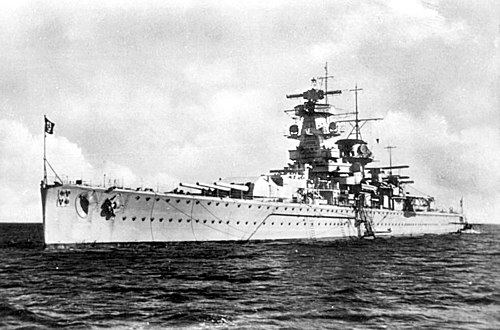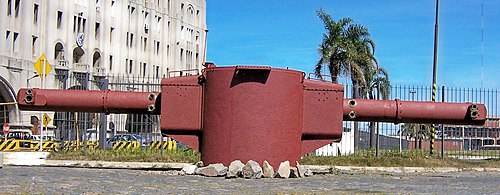KMS Admiral Graf Spee
KMS[1] Admiral Graf Spee was a German Panzerschiff (heavy armed cruiser) that was commissioned by the navy in 1936. It served as a South Atlantic commerce raider in World War II until it encountered Royal Navy vessels off South America. Badly damaged in the Battle of the River Plate, it took refuge in Montevideo harbour but was not given enough time by the Uruguayan government to complete necessary repairs. Rather than face the British ships again, Graf Spee was scuttled outside the harbour.
A "pocket battleship"
Having been commissioned by the navy in 1936, Admiral Graf Spee was erroneously reputed by Nazi propaganda to be a "pocket battleship". In fact it was a cruiser that had been specially optimised for commerce raiding, and it was built under treaty limits. Its main guns were 11", heavier than those used by Royal Navy cruisers but not of battleship calibre. The ship had an extended cruising range and good habitability, but poor armour.
Graf Spee left Germany before the outbreak of World War II and took up station in the South Atlantic. It was supplied by the oil tanker Altmark at pre-arranged rendezvous. Captained by Hans Langsdorff, Graf Spee successfully sank numerous British merchant ships, having first taken their crews into custody. The prisoners were transferred to the Altmark, from which they were later rescued by the Royal Navy in what became known as the "Altmark Incident".
Battle of the River Plate
On 13 December 1939, the Graf Spee was forced to fight three British cruisers – HMS Ajax, HMNZS Achilles and HMS Exeter – in the Battle of the River Plate. Graf Spee had the longer range of firepower and inflicted serious damage on the Exeter, but it was outmanoeuvred by the other two and suffered several hits which its light armour could not withstand.
Langsdorff headed up the River Plate to Montevideo, the capital of neutral Uruguay, to seek refuge in the harbour there. The Uruguayan government gave him 24 hours to complete repairs and embark, or they would impound the vessel. It was impossible to make the ship fully seaworthy in that time, especially as there were reports of a larger British force assembled in the estuary. In fact, Exeter had withdrawn and set sail for the Falkland Islands but had been replaced by another cruiser, HMS Cumberland, so the odds were unchanged.
Langsdorff waited for the deadline to expire and then ordered the ship to be moved into the outer harbour. The crew was evacuated and pre-set charges were detonated to scuttle the ship. On 20 December, Langsdorff wrapped himself in the old German Imperial Navy flag and committed suicide. The crew were later taken to neighbouring Argentina and interned there for the rest of the war.
The wreck
Attempts have been made since 2004 to raise the wreck but the work was halted because of financial and contractual issues. The ship's telemeter, or range finder, is displayed on the Montevideo seafront.[2]
References
- ↑ KMS = navy Schiff
- ↑ The fate of the Graf Spee. History Extra. Immediate Media (11 February 2010).

